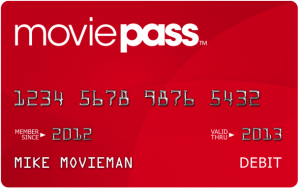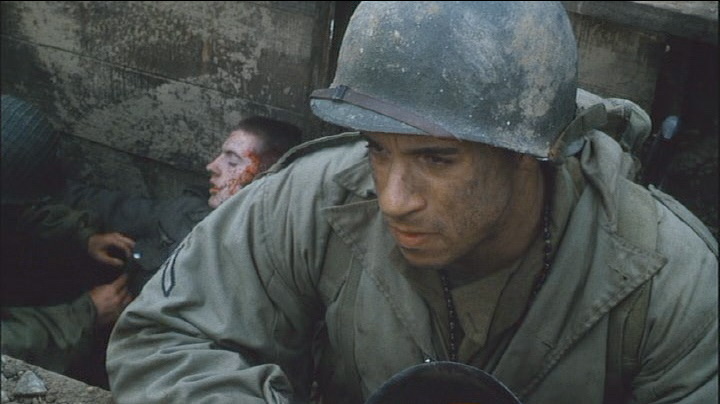In Which Andrew Tells… is a series of articles about a certain topic, film or event, where Andrew – the unlikely voice of reason – tells that particular topic, film or event a hard truth. Whether that be how a particular film could be fixed, or how well an event worked, this is solely Andrew’s opinion and is not always intended to be taken seriously.
Previous editions of In Which Andrew Tells…
…Oscar Winner Alejandro G. Iñárritu How to Fix The Revenant.
…How to Create Equality in Cinema.
———————————————————————————————————————————————————————————————————
You may have heard me talk about how many times I saw Steven Spielberg’s war epic Saving Private Ryan in the cinema (the answer is sixteen times). You may have wondered, what would drive a man to watch such a film sixteen times in the cinema? Well, let me hopefully run through a few reasons why someone like me would go and see a film sixteen times in a movie theatre.
I’ll set the scene – it was November 1998 and Saving Private Ryan (one of the biggest films of the year) was coming out. School was almost finished for the year and within my small group of friends, there was no film that looked more exciting than seeing Tom Hanks search for one man in war torn Europe. The marketing for Saving Private Ryan focused on the exhaustive and immersive twenty five minute violent opening. The poster displayed Tom Hanks, Tom Sizemore, Matt Damon and Edward Burns hovering over the silhouette of a man on a hill. It was an image that was burned into my mind.
I was already in love with films at that point, but at fourteen years of age I was becoming aware of specific names of directors behind films and knew to be excited for films from certain directors. I’d already experienced the healing powers of Jurassic Park after seeing it at nine years of age when I had chicken pox and was miraculously cured a few days later. I’d been creeped out by ET and his screaming in the corn field. I’d already criticised Hook for failing to tell an interesting version of the Peter Pan tale. I’d also had to sit through Amistad after buying a ticket for it intending to sneak into Starship Troopers and being caught by the usher. So, knowing that Saving Private Ryan was a Steven Spielberg film about war, well, I was excited. (To be clear as well, I hadn’t then – and still haven’t – seen his Best Picture winning Schindler’s List. I have however seen War of the Worlds multiple times – do with that information what you will.)
Back in the nineties, in school we had to provide proof of ID as a hand written concession card. It worked on an honour system – the student was to write their own details on the card, including their own birth date. You got one card at the beginning of the year and that was to last you til the next school year. After being turned away from seeing both Event Horizon and Starship Troopers (although I did get to see Starship Troopers twice in the cinema, as well as seeing Welcome to Woop Woop three times) because of their MA15+ rating, and the fact that at the beginning of 1997 I’d written by birth year as 1984 meant that I wasn’t able to see the films by myself (and I was hardly going to be able to convince my mum to come to see these films either – although I did later drag her to see There’s Something About Mary). January 1998 rolled around and I put my birthdate as 1982 – I had to make sure that any potential MA15+ films coming out in that year were able to be seen with my then fourteen year old eyes.
In 1997, Hoyts built a new cinema a short two minute walk from my school. I was a pretty good student, but I did skip school often to go and see films – sometimes just skipping the last period so I could see anything (this will be clear why soon enough) on the big screen. The day that Saving Private Ryan came out I feigned illness and didn’t go to school that day. My parents were both working that day so I somehow managed to get the lawnmower man to call in sick for me. I was in walking distance of school, and thus, also the cinema, and caught the first session of Saving Private Ryan. I then caught up with my friends when they finished school and we watched it again that afternoon. I saw it on the Saturday of that weekend, and then the Sunday as well. The following weekend, three times more, and then ten more times during its extensive run. Keep in mind, this was a time where films like Titanic lasted on screens for a solid nine months. Fortuitously, my school later enrolled the assistance of the security at the shopping centre to track down wayward students – fortunately, this was the year after I left.
At this stage, DVD was just coming round as the new format to view films at home. Players and discs were insanely expensive and the catalogue of films was limited. There were no LCD high definition screens at the time, it was rear projection all the way and even then, it was usually a screen the size of a milk crate. Understandably, I wasn’t sure what the future of home viewing was going to be like – of course, we all dreamed of having our own home cinema with full surround sound, plush seats, fresh popcorn and no interruptions, but in 1998, I didn’t know how far away that would be. Up until 2015, I wasn’t sure I’d ever get the chance to see Saving Private Ryan on the big screen ever again, and certainly in 1998/1999 I wasn’t sure I’d ever get to experience what I experienced on that opening weekend ever again either.
Saving Private Ryan – and later The Matrix and Spider-Man – was the epitome of a film that demanded to be seen on the big screen. Sitting down to watch this grand war film for the first time was as explosive and life changing for me as it would have been for those seeing Lawrence of Arabia or Star Wars on their initial runs. The surround sound of the waves crashing on Normandy Beach as bullets whiz over soldiers’ heads fully encompassed you alongside the immersive power of the massive black screen. Janusz Kaminski’s Oscar winning cinematography is the sort of cinematography that demands to be seen on the biggest screen possible – and not just for the superb action sequences, but for the smaller moments as well like a late walk through a field of flowers, or the heart breaking death of Caparzo in the rain. This is a grand, big scale, epic film.
Did it deserve sixteen viewings at the cinema? Well, probably not, and if the same film were released today, the only thing stopping me from going sixteen times would be the fact that I now work full time and see a lot more movies than I did then. Also, the theatrical run for some films is greatly reduced. No longer are there month long engagements for popular films. I am glad that I saw Saving Private Ryan sixteen times at the cinema. For each of those times – whether it was me going with my friends, or going with my Grandfather, or even the times I went by myself – I experienced something that only the power of going to the cinema can do. The power of immersing yourself entirely in a film with the greatest tools that a cinema can provide – that massive screen, those powerful speakers, the pure darkness of the expansive room.

So, there’s about 1200 words on why I saw Saving Private Ryan in the cinema sixteen times, let’s finally get to the point of this article. In the last few years we’ve seen the massive rise of streaming services and in turn, the death bells for cinema endlessly ring long into the night. ‘The End is Nigh for Your Favourite Cinema Complex’, and if these endless articles are to be believed, when Star Wars: Episode XV: Chewbacca & Maz Kanata Get Married is released, you’ll be watching it on your home TV or mobile device dressed in your best Jedi garb instead of trundling along to a midnight screening laughing at anyone who decides to turn up as Jar Jar Binks.
But, just like the eternal format of music that is vinyl, cinemas will always be around. And oddly, it’s going to be in spite of itself. There has been the continual desire to introduce new gimmicks to cinema to encourage people to enter the large dark rooms and try out the ‘great new thing’. Whether it be the continual push of the 3D format onto audiences, or the roll out of IMAX and its many off shoots, there always seems to be a certain type of gimmick to try and get people into cinemas. Even Oscar winning directors like Quentin Tarantino fall into the ‘gimmick’ aspect of cinema with films like The Hateful Eight and its 70mm ‘Roadshow’ version which only certain cinemas were able to display. Yet, do any of these gimmicks ever elevate the films that they’re helping present?
Well, yes and no. For films like Gravity, the 3D aspect worked to the films benefit in displaying the supreme vastness of space. As you see Sandra Bullock and George Clooney float through space, the 3D helps display them as a silhouette against the endless black void. Yet, for other films like The Avengers, the 3D aspect merely acted as a cinema tax, adding little to the film at all other than an ability to deliver brutal headaches from a nauseating poor 3D conversion. The same rule applies for IMAX and its offshoots. A film like Interstellar used the IMAX format to perfection, again encompassing the viewer in the supreme vastness of space and corn fields. On the flipside, IMAX cinemas often fill their down time with nature documentaries that I often doubt would manage to fill enough seats. (This is no slight on nature documentaries, I love them a lot, however given how often they fill session times at genuine IMAX cinemas helps show how little content is available for that format of cinema. Although, I will eternally vocally request a proper IMAX theatre in Perth.)
While I could bring up the Grandfather of Gimmicks himself, William Castle, with his array of cinematic wonders to help boost the antics going on on screen, they are aspects of cinema going that has long since been forgotten. Although, given the quality of some of the modern films, I probably wouldn’t mind a random element like an electric shock in my seat to help boost the interest and excitement in the film.
Discussions from cinematic masters like Steven Spielberg and James Cameron have popped up throughout the years as to ways to increase or improve the cinematic experience. Everything from extending the screen projection to the floor, roof and walls, through to films being projected in 48 frames per second to provide a ‘hyper-real’ projection. The latest way to change film viewing is a set top box-esque item which will allow day one rental for films. While this is still in prototype stage, the general idea is that you pay a yearly fee to have the ability to access films on day one, of which you will need to pay an extra $50 to access each film. Many people were on board with the idea stating the desire to watch a film in a cinema without being interrupted by mobile phones and talkers, others talked about the fact that the cost of going to the cinema is expensive and this sounds like a cheaper option.
I won’t break down the pros and cons of this device here, except to say that the idea is fucking stupid and will never truly succeed. What I will go into is the discussion of why a device like this is even in the discussion as being a genuine alternative to watching films at the cinema. One could ask, why is an alternative to cinema even being discussed when box office records are being broken left right and centre? Aren’t cinemas making a killing with films often breaking the $1 billion mark at the cinema?
Well, yes and no. While I don’t have an exact breakdown of where the money from a films run at the cinema goes, it usually goes like this: the distributor gets the most of the cut during the first week or two, then for the remainder of the films run, the theatre itself gets the money. Even then, the cost of the ticket is greatly dispersed amongst a bunch of different elements –wages for the staff, advertising, maintenance, etc. – all of which make up the average ticket price in Australia of about $17 (for an adult ticket).
However, knowing exactly where your money goes when paying to see the latest film at the cinema doesn’t make swallowing that $17 charge per ticket any easier. When breaking down what your visit to the cinema will cost for you and your family, it quickly adds up with just full price tickets alone – two adult tickets, and two kids tickets throws the visit up over the $60 mark. Throw in potential popcorn purchases, and the visit suddenly skyrockets over $100. A $100+ visit to the cinemas for working families suddenly makes movie going a financially restrictive endeavour. Even without candy bar purchases it can be financially restrictive.
Touching on the set top box idea – the concept sounds great for working families, especially when you factor in the costs of going to the cinema. However, when you look at it, the $50 per film doesn’t include the potential hiring of the system per year. Factor in the predicted $300 subscription fee for the device per year and suddenly the $100 jaunt at the cinema has turned into a $100 jaunt at home without the cinema quality presentation and equally shitty popcorn. The fact that stats have shown that people are even more easily distracted at home – FOMO causing constant social media monitoring, all the while the $100 film you’ve paid to watch runs on the TV.

AMC Theatres in America briefly announced (and then just as quickly, retracted) that they were going to introduce mobile phone allowed screenings – meaning, people can text, tweet, instagram, tinder, whatsapp, snapchat, whatever til their hearts are content while whatever madness occurs on screen. I’ve been fairly vocal about the sanctity of cinema and the terrible rise of talkers and texters in screenings, and no doubt, my old man grumbling will continue til the day I die. The amount of people who are afraid to address these talkers is understandable – they don’t want to seem like the asshole in the situation. But, just like everyone else, when you buy a ticket to see a film in the cinema, you’re signing an unspoken contract that you will remain quiet throughout the film – even though the ads prior to the films request as much as possible to turn your damn phone off. Alamo Drafthouse Cinemas in the US have made this a policy and have had great success with their no talking, no texting policy. After all, you didn’t slap down $17 to have the right to have a conversation with your friend in a dark environment about what you’re doing that weekend. You paid to see a film. Depending on your wage, you possibly worked a whole hour of your life to be able to afford this privilege of viewing a film at the cinema.
So what can cinemas do to make the act of going to see a film more palatable? For starters, stop slapping on novelty elements to films like 3D and IMAX – the film itself should be enough of a drawcard to get people to see it, rather than having to pay extra for something that will potentially hamper the enjoyment of the film. Yes, I thoroughly love the genuine IMAX experience, but the leasing of the IMAX brand and the ability for cinemas to simply slap on a MAX to the end of a larger sized screen and call it a day is a modern day lie. That is not traditional IMAX and it’s disappointing that audiences are hoodwinked into believing it is.
Secondly, address the ticket prices. Now, I see a lot of films – usually two a week at the cinema, three if time permits. This wouldn’t be possible if it weren’t for discount tickets that are provided by partnerships created by companies like Optus and Telstra. If you are an Optus or Telstra customer (and if you’re not, there are ways around that), then you have access to cheaper tickets for films every day. Depending on what cinema is nearby you, you could use your Optus account to get $10 movie tickets for the affiliated cinema. This immediately makes attending films much more affordable. If you’re not an Optus or Telstra customer, then fear not, you don’t have to sign your life away to a 24 month phone contract just to get $10 film tickets – instead, you can easily buy a $2 pre-paid SIM card and create an account to gain access to these discount tickets. Some news agencies still sell discount cinema tickets, and besides Optus and Telstra, there are other groups who regularly provide discount tickets of some sort.
But, the thing is, we shouldn’t have to sign up to phone companies or sacrifice a lamb to get discount tickets. The discounts should ideally come from the cinemas themselves. Now, there are some cinemas who provide discount prices all day long and it works wonderfully for them – notably in Western Australia, Belmont Reading Cinema’s $10 movie tickets is a welcome thing. Hoyts do have Hoyts Rewards cards where there are weekly discount films, as well as free tickets given for having watched a certain amount of films – although this does have a yearly fee. Event Cinemas have Cinebuzz which is a free service that also allows you to get discount tickets and also to gain a free ticket for having watched a certain amount of films as well. Both are great, but even then they still don’t go far enough to address the price of movie going.

That’s where the concept of subscription services for cinemas comes in. We live in a world where almost anything can be provided as a subscription service – Netflix for TV, Loot Crate for toys, heck, in the US you can even subscribe to getting new socks and underwear every month – so logically, cinemas should have a subscription service in place. In the US, there is a concept called Movie Pass, this is a subscription service where you can have access to watching one film every 24 hours in a month. It’s a fantastic idea and one that encourages people to get into the cinema to watch films. Odds are, people will gladly go and see films they wouldn’t usually see if there’s less of a cost to them each month. It’s amazing what people will watch when there’s not a $17 price tag on it.
I yearn for a day where this idea is implemented into Australian cinemas as it would ideally encourage people to get out and watch films more often. It takes the sting off having to pay a huge amount per ticket – benefitting the filmgoer; but also benefits the cinema by monopolising on those that may only go and see one or two films a month with the subscription. I would be more likely to purchase items from the candy bar if I were able to pay less for tickets.
The other reason why it would be hugely beneficial for Australian cinemas, is that it could potentially have a flow on effect for Australian films. As mentioned, the average adult ticket price is $17, so when weighing up what latest film to see, odds are people will go with something that’s familiar and safe with actors they recognise or a story they know, rather than seeing something Australian. It’s always been a sad state of affairs that Australian cinema hasn’t ever truly found the box office success that it deserves. Yes, 2015 was a great year for Australian cinema with The Water Diviner, The Dressmaker and Paper Planes all doing great numbers, but, if cinemas were to implement something like a movie pass system into Australia, ideally people would be more willing to take a chance on Australian films if they know that it’s not going to cost them as much.

Sure, still implement a premium price for those 3D or IMAX films, or maybe even have a higher tier for those services and other Gold Class-like services, but if the fee for a subscription service was set at a reasonable price – in Australia, maybe $50 a month? – then I would say that attendance would increase greatly. Understandably, this possibly wouldn’t work as well for smaller arthouse cinemas, but for the Hoyts’ and Event and Village Cinemas’ of the world, it could be a great success.
I may decry the current superhero movement and its undying reign as being the death of creativity within films – but I am thankful for the supreme fanboy who returns to the cinema four, five or six times on the opening weekend to see the latest exploits of Man in Costume and Sidekick Boy. While these films may not be for me, I understand that audiences desire to attain a similar feeling that I had when watching Saving Private Ryan. I’m thankful that these films keep the lights on in cinemas, even if I am concerned about their domination and the effect they have on cinema as a whole – but that’s a subject for a different article at a different time.
Cinema won’t die – that’s a given. No matter how many new services that are released that attempt to deliver films to you in as quick a way as possible, the massive dark room with a story being projected on a wall and a bunch of strangers appreciating that story, will always exist. I do hope that cinemas don’t become a niche environment the same way that playhouse theatres or art galleries have. After all, there is something otherworldly about surrendering yourself to a story and letting it wash over you entirely. Not all films will provide that same feeling that I got with watching Saving Private Ryan, but that’s part of the joy of cinema, of exploring new stories, new emotions. Films like Sherpa and Once Upon a Time in Anatolia are both films that I feared wouldn’t get cinematic releases, but I’m glad they did as the sheer power of the massive dark screen helped enhance the emotional power of the films. The feeling of being dwarfed by the film is a powerful feeling – maybe not one that every cinema goer gets, but it’s one that I keep seeking out whenever I go to the cinema. I just wish that there was less desire to trying and reinvent the wheel with cinema – it is a perfect enough medium as it is, no matter how many bells and whistles that are attached to it, the core feeling of watching a film in the cinema will never change. Hopefully one day cinemas will realise that to get people to come along to see films, they simply need to make it more affordable for audiences.



